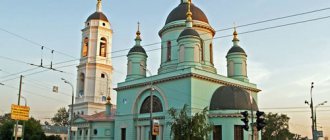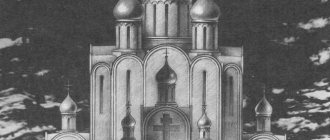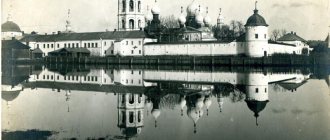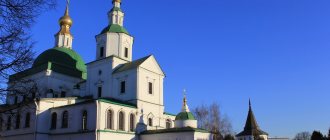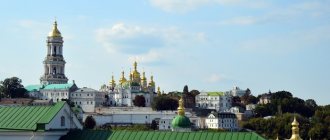| Moscow St. Daniel's Monastery |
Moscow men's monastery in the name of St. Daniel the Stylite
, stauropegy of the Russian Orthodox Church within the boundaries of the Moscow diocese
- Address: Russia, 115191, Moscow, st. Danilovsky Val, 22
- Tel.: 961-1480
- Official site:
- Directions:
- Metro "Tulskaya" (from the center - the last car), after exiting the metro, turn back, walk to the tram tracks and turn right, go straight to the monastery
- Metro "Paveletskaya", then by any tram to the stop "St. Danilov Monastery"
The monastery in the name of the Monk Daniel the Stylite was founded no later than 1282 by the holy noble prince Daniel of Moscow on the right bank of the Moscow River, five miles from the Kremlin.
This was the first men's monastery in Moscow. On March 4, 1303, at the age of 42, Prince Daniil died, having shortly before taken monastic vows into the schema, and, according to his will, was buried in the Danilov Monastery. In 1330, the brethren of the Danilov Monastery were transferred to the Kremlin, where a new monastery, Spassky, was built at the Church of the Savior on Bor. The Danilov Monastery itself was desolate for almost two and a half centuries. In its place there was a small church, which became a parish church, and a cemetery.
In 1560, under Tsar Ivan the Terrible, the Danilov Monastery began to be revived, and monastic life was resumed there. In 1561 St. Metropolitan Macarius consecrated the first stone church in the monastery in honor of the Holy Fathers of the Seven Ecumenical Councils (the first church in the history of the Orthodox Church with such a dedication).
In 1591, the monastery played a big role in repelling the attack of the Crimean Khan Kazy-Girey.
In 1606, near the Danilov Monastery there were battles between the troops of Tsar Vasily Shuisky and the rebels led by Bolotnikov, who were defeated. In 1610, the impostor False Dmitry II, who fled from Moscow, set the monastery on fire, but was soon rebuilt and surrounded by a brick wall with seven towers.
In 1652, the relics of the Blessed Virgin Mary were found in the monastery. book Daniel.
Construction of the monastery wall with eight towers in the second floor. The 17th century, under John, gave the monastery the significance of a fortress.
During the Patriotic War of 1812, the French desecrated and robbed the monastery churches and stole a silver frame from the tomb of St. Prince Daniel.
In the 19th centuries. At the monastery there was an almshouse for elderly clergy and widows of the clergy; one of the oldest Moscow cemeteries was located on the territory of the monastery. Many outstanding figures of Russian culture were buried at the Danilov Monastery cemetery: the great Russian writer N.V. Gogol, poet N.M. Yazykov, artist V.G. Perov, musician N.G. Rubinstein and many others.
After the revolution, churches gradually began to be taken away from the monastery. Formally, the monastery was closed in 1918, but monastic life in the monastery continued.
In 1930 [1] the Danilov Monastery was finally closed - the last in Moscow. Until 1932, the remaining part of the brethren served in the Church of the Resurrection of the Word in Danilovskaya Sloboda. The majority of the brethren of the monastery were shot in 1937. The relics of Saint Prince Daniel disappeared without a trace. After the monastery was closed, the churches were devastated and rebuilt, the graves of the most famous people were moved to other cemeteries, and the Danilovsky necropolis was destroyed. A colony for juvenile delinquents and warehouses were set up on the territory of the monastery.
In May 1983, the monastery was the first to be returned to the Russian Orthodox Church. For the celebration of the 1000th anniversary of the Baptism of Rus' in 1988, the monastic monastery was restored. All three churches that existed before the revolution were restored, and two new churches and two chapels were built. In the basement of the hospital building, the first chapel in Moscow (later the temple) of St. Seraphim of Sarov, in the built building of the patriarchal residence there is a church in the name of All Saints who shone in the Russian land. The bell tower with the Church of St., demolished in the 30s down to the first tier. Daniel the Stylite was rebuilt.
| Moscow Danilov Monastery. Scheme |
The monastery has been restored to its historical appearance in the 17th-19th centuries.
The oldest of the monastery's churches is the Church of the Holy Fathers of the Seven Ecumenical Councils, a complex structure that includes several churches. After restoration, the iconostasis of the Kostroma school of the 17th century was installed in the temple. On the ground floor there is the Church of the Intercession of the Blessed Virgin Mary. Trinity Cathedral is the largest cathedral of the monastery. Built in 1838 according to the design of the architect O. Bove in the style of late Russian classicism. The main altar was consecrated by the holy Metropolitan of Moscow Philaret (Drozdov). After restoration, the interior of the cathedral was recreated in a form close to the original. This cathedral contains miraculous icons: the Mother of God “Three-Handed” and St. John Cassian the Roman. Sunday and holiday services are held in the Trinity Cathedral. On September 4, 1997, a monument to the holy noble prince Daniil of Moscow was opened and consecrated on Tula Square.
On March 17, 1998, a chapel in honor of the Holy Blessed Prince Daniel of Moscow was consecrated on Tula Square. It was recreated according to a new architectural design near the site of the original chapel, which was demolished after the revolution and had a 300-year history.
In 2003-2008 Through the efforts of the brethren of the monastery, with the financial support of the Link of Times Foundation, with the active assistance of the administration and students of Harvard University in the USA, a set of 18 historical bells was returned to the Danilov Monastery, which in the 1930s, on the initiative of a member of the American charitable mission in Moscow, a research fellow at Harvard University To save Thomas Whittemore from being melted down, it was bought by the American industrialist Charles Crane and donated to Harvard University.
The main shrine of the monastery is particles of the relics of the holy noble prince Daniel of Moscow, located in arks in the cathedrals of the Trinity and the Holy Fathers of the Seven Ecumenical Councils. The first particle of the relics of Saint Prince Daniel after the revival was transferred to the monastery in 1986 by Archbishop of Washington, Metropolitan of All America Theodosius.
The monastery has metochions: in the Ryazan region, in the Moscow region and the Church of St. Nicholas in Izmailovo.
Danilov Monastery is stauropegial, that is, its abbot is His Holiness the Patriarch of Moscow and All Rus'. The daily life of the monastery is managed by its abbot with the rank of archimandrite. According to its charter, the Danilov Monastery is a cenobitic monastery - common prayer, work and meals for the monks. Divine services are held daily. The brethren of the monastery participate in charity and mercy works in medical and children's institutions, in places of detention, and teach in secular and religious higher educational institutions. The monastery operates a Sunday school, catechetical courses for adults, the Danilovsky Blagovestnik publishing house, an excursion service, and various workshops. A “Helpline” has been organized.
The monastery is open to visitors from 6:00 to 21:00. The monastery does not have its own hotel and therefore cannot offer accommodation for pilgrims.
On the territory of the monastery there are:
- residence of the Patriarch of Moscow and All Rus'
- Department for External Church Relations of the Moscow Patriarchate
- Patriarchal Center for the Spiritual Development of Children and Youth
- World Russian People's Council
Gaming room CatCasino
The project offers you to play slots from Nolimit City, Evolution, NetEnt, Microgaming, GameArt and many other manufacturers. The site has excellent games, including classic and newest machines in different themes. This allows you to play as comfortably as possible and constantly get variety in the gameplay.
The site has the following game features:
- slot machines with spinning reels – classic software with bright winnings;
- cards and tables - many games offering pleasant opportunities to immerse yourself in an atmosphere of excitement;
- live dealers – the opportunity to play with real dealers and use the game without the participation of computer algorithms;
- other types of software - there are games that are difficult to include in other categories.
The game catalog is extensive - over 1000 excellent games are presented. The portal is also working on adding new slots and presenting new providers. This expands the gaming experience for users.
Tourist information
The Danilovsky Monastery in Moscow is stauropegial, that is, its abbot is His Holiness the Patriarch of Moscow and All Rus'. Everyday life is managed by his viceroy in the rank of archimandrite. According to its charter, the Danilovsky Monastery is cenobitic, which means common prayer, work and meals for the monks. The brethren of the monastery participate in charity and mercy works in hospitals, children's institutions and in places of detention. In addition, teaching is carried out in secular and religious higher educational institutions.
There is a Sunday school and catechetical courses for adults (the doctrine of the Orthodox faith is taught). The Danilovsky Blagovestnik publishing house and various workshops are located here. There is a tour service. There are farmsteads in the Ryazan region and in the Moscow region. There is a church of St. Nicholas in Izmailovo, which is the tallest wooden church in Russia. Its height is 46 meters.
162930
author: Dmitry Kazakov
Registration and start of the game
The registration process consists of two extremely simple steps:
- In the first step, select whether you want to receive a welcome bonus. Hint – of course, it’s better to get it.
- Next, you need to enter data - name, email, password, country of registration.
- Also at this step you need to select the currency of your account.
- You can also enter a promotional code in the registration field.
At this point, registration is completed, you can log into your personal account. Don't forget to confirm your email address to activate all account features.
Tomato sauce
You will need: onions 30 g, carrots 30 g, tomato paste 20 g, vegetable oil 20 g, water 100 g, salt, sugar, pepper, ground dry basil - according taste.
. Preparation: peel onions and carrots, cut into large pieces, fry in oil, add tomato paste, sauté for 15 minutes. add water, cook for 40 minutes, add salt and spices to taste, blend in a blender until a homogeneous mass is formed, bring to a boil in a saucepan.
Bonuses and promotions on the CatCasino website
The main welcome bonus consists of cash gifts and free spins packages. You can receive money with a small wager for your first deposits. The system is simple - the more money you enter on the site, the more bonus funds you can receive. Free spins packages help you win even more at the very beginning of your player journey, without spending real money from your account.
You will also enjoy the following bonus features:
- Random bonuses in the form of free spins packages for players are a great way to increase the intensity of excitement and increase the account size.
- Nice cashback for those players who lost money. You can return a certain part of the loss.
- Situational bonuses for activity - many additional gifts that are valid temporarily. You need to keep an eye out for new promotions.
- Short and long tournaments with large prize pools. Win tournaments for even more money and additional winning opportunities.
Danilov Monastery
History of the Danilov Monastery
Archaeological evidence confirms the existence of wooden churches on the site of the Danilov Monastery from around the 14th century; more specific information has not yet been found. Historical sources call the founder of the monastery the Moscow prince Daniil Alexandrovich, who received his name in honor of the outstanding Christian of the 5th century Daniel the Stylite. The latter was an ardent follower of Simeon the Stylite after witnessing the saint's many years of feat. On his pillar in the vicinity of Constantinople, Daniel stood for about 30 years, showing the world all sorts of miracles of healing the suffering, after which he died peacefully in what was at that time a ripe old age at the age of 80. It is with these church figures: the two Daniels and Simeon that the main objects of worship of the monastery are associated.
Danilov Monastery in an 18th-century engraving
Danilov Monastery in a photograph from the late 19th century
History of the stone ensemble
The construction of the Church of the Holy Fathers of the Seven Councils was completed in 1560, after which a year later it was consecrated in the presence of Ivan the Terrible. During the Time of Troubles, during the years of the Bolotnikov uprising, the Danilov complex unwittingly found itself in the thick of events - devastating battles and executions took place next to it. In the 18th century, 20-30 members of the brethren felt more relaxed; no one encroached on the peaceful course of monastic life.
More problems began in 1812, when the sacristy and other valuables were evacuated to Vologda and the Trinity-Sergius Lavra, but were never returned. Otherwise, in the 19th century, the Danilovsky Monastery flourished: although the number of monks remained modest, land plots grew and possessions appeared outside its territory.
Church of the Holy Fathers of the Seven Cathedrals
Entrance to the temple
Decline and revival of the monastery in the twentieth century
After the revolution, disgraced bishops who did not support Patriarch Tikhon were gathered in the Danilov Monastery. In 1929 it was closed by decision of the NKVD. The bells were taken to the USA, the necropolis was destroyed, the ashes of Gogol, Khomyakov, Yazykov were transferred to the Novodevichy cemetery, the remains of the artist Perov were transferred to the Donskoy Monastery. Many manuscripts and books were transferred to the state archive. A special detention center was opened in the former monastery: children of those repressed at the Butovo training ground were brought here. The mortality rate among the unwanted pupils was enormous, and new, now nameless, burial places appeared near the monastery walls.
In 1983, under Patriarch Pimen, a decision was made at the state level to return the monastery to believers. At first they talked about the Donskoy Monastery, then, after Brezhnev’s death, the authorities chose Danilov. In the 80s, the reconstruction of cathedrals and utility rooms began simultaneously with the construction of the patriarch's residence. Several years ago, the residence was reconstructed, after which the monastery continued to operate as usual: a small part of it is open to parishioners, the rest is under the vigilant guard of the Cossacks.
Remains of the lost necropolis
Temples of the Danilovsky Monastery
The oldest temple of the monastery, the Church of the Holy Fathers, lasted less than 200 years in its original form. In 1730 it was dismantled, and a new one with the same name was built on the base of the nearby 17th-century Church of the Intercession. The architectural experiments did not end there. In 1806, two chapels were built over the Cathedral of the Holy Fathers: the southern one is dedicated to Boris and Gleb, the northern one is dedicated to Daniil of Moscow.
As a result, instead of one patronal feast day, several are celebrated in the Church of the Holy Fathers - each in its own department. The main celebration in honor of the Ecumenical Councils takes place on May 31. From the Church of the Intercession, from the ground floor of the Church of the Seven Cathedrals, on October 14, a religious procession takes place around the building and the nearby Trinity Cathedral. The chapel of the Church of the Intercession is dedicated to the prophet Daniel, whose patronal feast day is celebrated on December 30. The Church of Daniel the Stylite is built in the third tier of the Temple of the Seven Councils; his day is celebrated here on December 24.
The builders of the monastery could not forget about the teacher of Daniel the Stylite - Simeon. The gate church of the 18th century, topped with a 45-meter bell tower, is dedicated to this saint. The ceremonial service takes place here on September 14. The Church of the Nativity of John the Baptist in the basement of the Trinity Cathedral and the Church of Seraphim of Sarov on the site of the chapel in the hospital building were built recently, in the 80s of the twentieth century.
Gate church with bell tower
Trinity Cathedral
Church of Seraphim of Sarov
Architectural features of the ensemble
The main distinguishing feature of the architecture of the Danilovsky Monastery is its eclecticism: the complex combines buildings of various styles. Visitors enter the monastery through the ornate Holy Gate of 1681 with the baroque bell tower of Simeon the Stylite - the most striking part of the complex. The strict brick wall with seven towers surrounding the Danilov Monastery appeared earlier than the entrance group - at the beginning of the 17th century.
The building of the Temple of the Seven Cathedrals is unique in the number of churches united in it. The lower floor, the Church of the Intercession, is distinguished by the modesty of low vaults without paintings. The upper part, the actual Church of the Holy Fathers, is designed in the Moscow Baroque style. Trinity Cathedral 1833-1838 - a bright representative of the Moscow Empire style with a portal decorated with six columns and an 8-window drum topped with a dome. Presumably, its architect was Osip Bove, the author of the Manege, Alexander Garden, Bolshoi Theater and many other iconic Moscow buildings. According to other sources, Evgraf Tyurin, also a very famous architect who created the Krutitsky barracks and the Yelokhovsky Cathedral, took part in the development of the project. Since the 19th century, only the outer shell has been preserved; after it fell into the hands of the NKVD, the building was completely rebuilt inside. Upon the return of the monastery to the church, the interior was restored according to surviving records and illustrations.
Eclecticism of the monastery ensemble
Strict monastery walls
Danilov Monastery
Residence of the Patriarch
In the western part of the monastery complex there is a specially protected object - the Synodal residence of the patriarch. The two-story building was built according to the design of Yuri Rabaev, one of the authors of the Tomb of the Unknown Soldier near the Kremlin walls. As a result of his efforts, a classic regional party committee was created with elements of church architecture - tent towers and mosaics depicting the Savior. On the second floor of the residence there is the house church of All Saints. Here the naming of bishops is carried out before the new Orthodox hierarch is consecrated in the Cathedral of Christ the Savior. In 2011, the Synodal Residence was completely renovated, explaining this need by imperfect construction technologies of 25 years ago.
Residence of the Patriarch
Shrines of the monastery
The burial place of the founding prince was forgotten, but in 1652 the relics were found and buried in the Church of the Ecumenical Councils. In 1932, after the closure of both the monastery and the churches located next to it, Daniel’s remains disappeared. In the 90s, particles of the relics, preserved through the efforts of the surviving hierarchs in the country and abroad, were returned to the Danilov Monastery. The reliquary returned to the cathedral under the northern arch; the ark, which came from America, is now kept in the Trinity Cathedral. Two more icons with relics - on the lectern and between the iconostasis. The discovery of the relics is celebrated in the chapel of the Church of the Seven Cathedrals on September 12. Every year on September 17th the day of death of the saint is remembered.
The Church of the Intercession contains a shrine with the relics of St. George, who was exiled to Kazakhstan after the revolution and died in 1932 on the way from exile. The Trinity Cathedral contains a fragment of the remains of Alexander Nevsky, and the Church of Prince Daniel in the Cathedral of the Holy Fathers contains a particle of the relics of Nicholas the Wonderworker. Here you can also see the ark of Spyridon of Trimifuntsky with his shoe.
Ark with the relics of St. Daniel
Icon of St. Daniel of Moscow
Ark of Spyridon of Trimifuntsky with his shoe
Monastic production
Employees of art restoration workshops paint churches, create icons, jewelry for the Orthodox Church, icon cases and arks made of wood. The Danilov Monastery has its own workshop for the production of bells with master classes and training for bell ringers. It produces new bells and reconstructs old ones; specialists participate in the design of belfries, calculating the sound of instruments, and conduct examinations.
The history of the original Danilov bells is dramatic: in the 30s, the originals were miraculously taken to the USA and stored at Harvard University. In 2007, they were exchanged for exact copies, and Vekselberg became the delivery sponsor. Thanks to a successful deal, since 2010 the monastery hosts a festival of Russian bells on the last Sunday of September.
Danilovsky bellsRules of conduct in the monastery
Since the Danilov Monastery is active, and also for men, it has its own restrictions on visiting. Women come exclusively in skirts and put on a headscarf when entering the territory; men take off their hats when entering the temple. During worship, women are recommended to stand on the right, men on the left. Women are not allowed to enter the temple with painted lips: they are expected to kiss the cross. The first to receive communion are the monks, then the children, the men, and finally the women.
Cossack guards walk throughout the territory, keeping order. Taking photographs in the monastery is prohibited, especially of the monks, otherwise the Cossacks will intervene.
Parishioners
In the temple
Visitors to the monastery
Shopping at Danilov Monastery
There are shops on the territory of the monastery, next to it, on Danilovsky Val, and on the Internet. In the tent from 8 to 20 o'clock you can buy reproductions of paintings by Orthodox artists or even originals, for example, a ceremonial portrait of Patriarch Kirill. “Monastic Honey” sells products from Greece, honey and bread of its own production, non-alcoholic balm, skin care cosmetics, lean semi-finished products and spirulina. Other monastery shops sell leather goods with Orthodox symbols: belts, key rings, purses, bags, key holders, as well as T-shirts with paintings, icons and icon cases.
Divine services
In the St. Daniel's Monastery they do not baptize, do not perform weddings or perform funeral services; they only accept personal requests for prayers for health and repose. Urgent issues can be resolved with the priest on duty from 9 a.m. to 5 p.m. in the reception area, on Sundays and holidays - from 12 p.m. Solemn services on patronal holidays are held in the churches of the monastery. Confession begins at 7 am in the Church of the Holy Fathers. At 6, 7 and 17 o'clock on weekdays, daily prayer is held in the Church of the Holy Fathers; on Saturdays and on the eve of holidays, from 17 o'clock in the Trinity Cathedral, the All-Night Vigil begins. On weekends, liturgy is served at Trinity at 8.45, and at 6.45 in the Church of the Seven Cathedrals. Another service takes place on Sundays at 17:00 in the Cathedral of the Holy Fathers.
Patriarchal service in Danilov Monastery
Souvenir from Danilov Monastery
Rest near the walls of the Danilovsky Monastery
Although there are no conditions for pilgrims to live on the territory of the monastery, outside its walls, on the southern side, the Danilovskaya Hotel, owned by the Patriarchate, was built. The establishment is secular in nature, equipped with a restaurant with a bar and a swimming pool. The cost of living in a double room with breakfast starts from 7 thousand rubles per day, three-room apartments with a four-poster bed and a hydromassage bath cost from 13,000 rubles. The hotel restaurant offers monastery cuisine; the cheapest item on the Lenten menu, buckwheat with mushrooms and onions, costs 250 rubles per serving.
Hotel "Danilovskaya"
How to get there
You can get to the Danilov Monastery from the Paveletskaya metro station by tram of any route to the stop of the same name. A more typical route is to walk from the Tulskaya metro station, starting from the last car from the center, about 300 m northeast along the tram tracks. Entrance to the Danilovsky Monastery is free from 6.30 am to 9 pm; inside you can have a snack at the kiosk with pastries.
Lenten cabbage soup
You will need: White cabbage strips 270 g, Small potato sticks 110 g, Carrot strips 35 g, Onion half rings 33 g, Black pepper. 1 g., Vegetable oil 15 g., Salt 3 g., water 150 g., Bay leaf 1 g., dill 4 g.,
Preparation: Place cabbage in boiling water, bring to a boil, add potatoes, cook until tender, add sautéed onions and carrots, salt, pepper, bring to a boil, and when leaving, add greens.
Lenten borscht
You will need: Beetroot strips 60 g, White cabbage strips 250 g, Small potato sticks 100 g, Carrot strips 35 g, Onion half rings 33 g, Black pepper 1 g, Vegetable oil 15 g, Salt 3 g., Tomato paste 30 g., water 150 g., Bay leaf 1 g., dill 4 g., vinegar 2 g.
Preparation: Stew beets, cut into strips, separately with vinegar and tomato paste. Place cabbage in boiling water, bring to a boil, add potatoes, cook until tender, add sautéed onions and carrots, beets along with the broth, salt, pepper, bring to a boil, and when leaving, add greens.
Schedule of services
For visitors, entrance to the territory is open from 06:00 to 21:00. Excursions – every day from 09:00 to 18:00. The church shop is open.
Daily:
- religious services are held
- You can order akathists, prayers and memorial services
- the sacrament of confession and unction is performed
Funeral, baptism and wedding ceremonies are not performed.
It should be remembered that the monastery is active, so you must follow the visiting rules: women must wear dresses or skirts below the knees, with their heads covered. Men should not wear shorts and must remove their hats.
